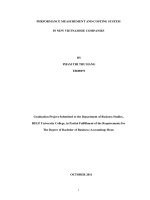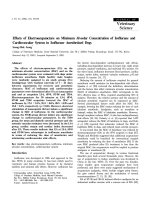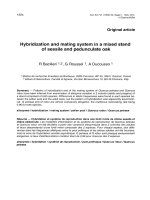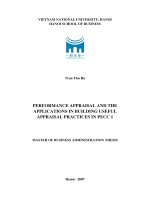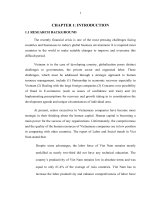performance measurement and costing system in new vietnamese companies
Bạn đang xem bản rút gọn của tài liệu. Xem và tải ngay bản đầy đủ của tài liệu tại đây (364.57 KB, 63 trang )
i
PERFORMANCE MEASUREMENT AND COSTING SYSTEM
IN NEW VIETNAMESE COMPANIES
BY
PHAM THI THU HANG
E0600071
Graduation Project Submitted to the Department of Business Studies,
HELP University College, in Partial Fulfillment of the Requirements for
The Degree of Bachelor of Business (Accounting) Hons
OCTOBER 2011
ii
DECLERATION
I hereby declare that the graduation project is based on my original work except for
quotations and citations which have been duly acknowledged. I also declare that it has
not been previously or concurrently submitted for any other course/degree at HELP
University College or other institutions. The word count is 12,778 words.
PHAM THI THU HANG
Date:
iii
ACKNOWLEDGEMENT
This graduation thesis is the result of twelve weeks of research and writing during the
autumn of 2011. It has been an interesting and learning experience. In fulfilling this
thesis, I would like to give my special thanks to many people for their significant help,
contribution, and recommendations during my writing process.
First and foremost, special mentions and grate thanks must go to Mrs. Nguyen Van Anh
, my supervisor at International School, Vietnam National University, Hanoi. With his
master knowledge and experience in writing thesis, he has wholeheartedly helped me in
writing this thesis. I could not have been able to complete this thesis without his
positive suggestions and guidance.
Secondly, I want to thank all the managers and staffs of Hungyen Garment Join stock
Company, for their cooperation that helped and inspired me in writing.
Thirdly, I would also like to give my heartfelt thanks to the authors who provided me
with valuable books for my thesis.
My appreciation is to my family and my friends for their supports and encouragements.
Gratefulness is to the readers also, whose feedback will help much in improving the
thesis.
Hanoi, October 2011
Pham Thi Thu Hang
iv
PERFORMANCE MEASUREMENT AND COSTING SYSTEM
IN NEW VIETNAMESE COMPANIES
BY
PHAM THI THU HANG
OCTOBER 2011
Supervisor: Mrs. Nguyen Van Anh
ABSTRACT
The graduation projects the results of research performance measurement and costing
system in new Vietnamese companies. The objectives of the project were to understand
impact of performance measurement and costing system in new Vietnamese companies
which show the importance of performance measurement and costing system. Benefits of
performance measurement and costing system will be required to improve the
competitiveness of new enterprises in the 21st century. A performance based costing
system was discussed, highlighting its capability to measure performance in such areas as
knowledge management and information systems, as well as performance across
functions and organizations. The steps for setting up that Performance Based Costing
system were described. Finally, a framework describing the relationship among
Performance Based Costing system components was presented in the hope that it would
provoke more thought on and development of the concept
In this thesis, the researcher uses case study of Hungyen Garment Join stock Company
because this Branch may be given more accurate information and able to take the right
actions.
v
TABLE CONTENT
DECLERATION ii
ACKNOWLEDGEMENT iii
PERFORMANCE MEASUREMENT AND COSTING SYSTEM iv
IN NEW VIETNAMESE COMPANIES iv
LIST OF FIGURES AND IMAGES vii
LIST OF ABBREVIATION viii
CHAPTER 1 - INTRODUCTION 1
1.1 Introduction 1
1.2 Problem statement 3
1.3 The objective of research 3
1.4 The structure of paper 5
2.1 Costing systems 6
2.1.1 The overview of costing system 6
2.1.2 The importance of costing systems 7
2.1.3 The type of costing systems 9
2.1.4 Design of a Performance Based Costing (PBC) system 13
2.2 A framework for measuring performance in new enterprise 17
2.2.1 Type of performance measurement 17
2.2.2 The importance of measurement performance 20
2.2.3 Issues with business performance measurement (BPM) 20
2.2.4 The framework for performance measurement in new company 24
2.3 Conceptual framework 26
2.3.1 Performance Reference Model (PRM) 26
2.3.2 Contingency theory 28
CHAPTER 3 - RESEARCH METHODOLOGY 31
3.1 Research objective 31
3.2 Research design 31
3.2.1 Research approach 31
3.2.2 Data collection 32
vi
CHAPTER 4 - DATA ANALYZE 34
4.1 Case study of a textile company 34
4.1.1 The introduction of Hungyen Garment Join stock Company 34
4.1.2 The producing 35
4.1.3 Market share 36
4.2 The costing system and performance measurement of the Hungyen
Join stock Company 36
4.2.1 The differences of costing systems 37
4.2.2 The set up of an accounting system of Hungyen Join stock
company 38
4.3 The designing performance measurement system in Hungyen Join
stock company 40
CHAPTER 5: CONCLUSION 44
5.1 Summary 44
5.2 The implementation 46
5.2.1 Accounting system 46
5.2.2 Costing system 47
5.2.3 Performance measurement 49
REFERENCE: 52
vii
LIST OF FIGURES AND IMAGES
Figures Title Page
CHAPTER 2:
Figure 1: Performance Reference Model 28
CHAPTER 5:
Table: Business Performance measurement critical success factors 51
viii
LIST OF ABBREVIATION
Abbreviation Full name
ABC Activity Based Costing
PM Performance Measurement
TDWI The Data Warehousing Institute
BPM Business Performance Measurement
SA Sustainability Analysis
SCM Supply Chain Management
ECR Efficient Consumer Response
GAAP Generally Accepted Accounting Principles
PBC Performance Based Costing
VCA Value Creation Area
CSFs Critical Success Factors
PRM Performance Reference Model
WTO World Trade Organization
FMS Foreign Military Sales
FMF Foreign Military Financing
1
CHAPTER 1 - INTRODUCTION
1.1 Introduction
In the 21st century, firms need not just operate in different countries; they must develop
global strategies to coordinate. Their operations at all phases of the value-adding chain
(D‘Amours et al., 1999). Coordination of the supply chain has become strategically
important as new forms of organization, such as virtual enterprises, global
manufacturing and logistics networks, and other company-to-company alliances,
evolve. The Japanese are often praised for the way they use information sharing to
improve supply chain competitiveness. Information exchange has become a key
component in their manufacturing strategies (Dyer and Ouchi, 1993). Companies in all
sectors are examining ways to reduce costs, shorten product development times and
manage risks. The transactions between companies in supply chains are characterized
by adding value up through the chain and incurring costs (and consequent payments)
down the chain. Supply chain management aims to reduce costs, risks and lead times
associated with these transactions, thus releasing value.
There is limited research on supply chain management in the low-volume Engineer to
Order (ETO) sector. This is in stark contrast to the extensive literature on high-volume
sectors, particularly the automotive sector (Hicks et al., 2000). Performance
measurement is critical to the success of any ―for-profit‖ organization because it creates
understanding, molds behavior, and improves competitiveness. World-class firms
recognize the central role measurement plays in their success and are often compulsive
about their performance measurement efforts (Fawcett and Cooper, 1998).
Activity Based Costing (ABC) is a product costing technique that has gained attention.
Turney,(1996) defined ABC as a method of measuring the cost and performance of
2
activities and cost objects. It assigns costs to activities based on their consumption of
resources and then allocates costs to cost objects based on their required activities. The
focus of ABC is on accurate information about the true cost of products, services,
processes, activities, distribution channels, customer segments, contracts and projects.
ABC helps identify problems and opportunities and formulate solutions to problems or
ways to take advantage of opportunities. It does so by providing financial and non-
financial information about activities and cost objects. Numerous articles address the
design and implementation of ABC systems (Shank and Govindarajan, 1993; Alan,
1995; David and Robert, 1995; Booth, 1996). According to Innes and Mitchell (1990),
ABC provides process control information. A measure of the volume of each activity
(cost driver) is used to generate a cost rate for estimating production cost, and as a
performance measure for the activity concerned. In practice, most applications of ABC
make arbitrary allocations of common costs. The search for the activities which connect
costs to products and processes, and for the cost drivers which proxy for them, involves
compromise between accuracy and manageability. The result is that some indirect costs
are excluded from the cost-pools associated with a practical set of cost drivers
(Armstrong, 2002)
Strategic performance measurement defines the focus and scope of management
accounting. Specifically the requirement is that management accounting practice
recognize and reflect choices made in organizations for management accounting to be
relevant (Atkinson, 1998). For the purpose of strategic performance measurement, the
organization‘s objective can be entirely financial, social, or a mix of both financial and
social objectives. It is widely believed that the large-scale use of EDI leads to
improvements in the communication infrastructure between organizations, and that this,
in turn, strengthens the economy of a nation and possibly a group of nations. It is also
3
widely recognized that EDI enables organizations to redesign their processes
significantly, because of its main capabilities: high speed, reliability and ease of data
capture (Sheombar and Wagenaar, 1991). Hoogeweegen et al. (1998) describe a
comprehensive approach for evaluating the value of various courses of action involved
in implementing EDI. The first relies on ABC and quantifies the costs and benefits that
are to be expected from the information processing when EDI is being used. The second
uses discrete-event computer simulation to quantify the costs and benefits to be
expected in the physical logistic processes.
1.2 Problem statement
This paper describes a framework for measuring costs and performance in new forms of
business organization that are evolving to meet the competitive challenges of the 21st
century. Therefore, the research questions will be as the following:
1. What are the advantages and disadvantages of performance measurement and
costing system?
2. How to estimate the most suitable performance measurement and costing
system in new Vietnamese companies?
3. What is the threat for a new enterprise in implementation performance
measurement and costing system?
4. What are the solutions for the above problems?
1.3 The objective of research
This paper highlights the importance of costing system and performance measurement in
the current manufacturing and market environment. Giving the guidance for the new
companies which are confused the suitable system for their operation.
4
Costing is basically the ascertainment of cost whether for a specified thing or activity. To
ascertain cost, we need to apply accounting and costing principles, methods and
techniques. In view of the complexity of businesses and increasing changes in industry,
trade and commerce, costing is becoming very important. It assist management to make
decision for example make or buy, whether to accept a special order and others, it assist
management in planning and control, costing assists management to appreciate scarce
resources in the increasingly complex business operations, understanding costing assist
in cost awareness, cost control / management, is vital to an organization‘s survival re:
using marginal cost in competitive tendering and others.
Improvement in individual, group, or organizational performance cannot occur unless
there is some way of getting performance feedback. Feedback is having the outcomes of
work communicated to the employee, work group, or company. For an individual
employee, performance measures create a link between their own behavior and the
organization's goals. For the organization or its work unit's performance measurement is
the link between decisions and organizational goals. It has been said that before you can
improve something, you have to be able to measure it, which implies that what you want
to improve can somehow be quantified. Additionally, it has also been said that
improvement in performance can result just from measuring it. Whether or not this is
true, measurement is the first step in improvement. But while measuring is the process of
quantification, its effect is to stimulate positive action. Managers should be aware that
almost all measures have negative consequences if they are used incorrectly or in the
wrong situation. Managers have to study the environmental conditions and analyze these
potential negative consequences before adopting performance measures.
5
1.4 The structure of paper
This research is divided to five chapters, each chapter has own responsibility.
Chapter one briefly will talk about the aim of this paper. Chapter two will about the
general view of costing systems and performance measurement and their importance in
a new company, chapter two will also orient for the research by theories and models.
Chapter three will give the answer of how the data can be collected and analyzed. The
result of the above data, information will be conducted in chapter four, it also supported
by the case study, and the last chapter will summarized the main ideas of the research
and the recommendations are possible for the implementing costing system and
performance measurement in Vietnam – a developing country.
6
CHAPTER 2 - LITERATURE REVIEW
2.1 Costing systems
2.1.1 The overview of costing system
Costing systems are components of a broader accounting system used by a given
company or organization. The main function of the costing system is to keep a focused
eye on expenditures made by the company. While the data that is collected and
generated by the costing system is also integrated into the overall accounting system,
the costing approach allows for easy extraction of the data for reports to upper
management.
The information that typically is gathered by a costing system allows owners and
managers to quickly identify the current status of two key factors that are relevant to the
success of the company. Operational costs are often the foundation of the data collected
by a costing system. Here, management is able to get a snapshot of all expenditures that
are directly connected with the general operation of the organization, especially in terms
of production costs.
A second important bloc of information that is retrieved with the use of a costing system
is performance cost. Here, management is able to view any and all expenditures that are
related to helping the companies remain profitable, less the direct cost of operations.
Expenses associated with marketing, public relations, and sales efforts are examples of
the type of expenditures that are captured in the performance cost module.
A costing system is not intended to replace an accounting system. Instead, the systems
actually work within the broad framework of general accounting systems to extract
specific data for quick and easy analysis. By making use of a costing system, it is
possible to quickly identify expenditures that were intended to benefit the company, but
7
are failing to do so in a significant way. This makes it possible for owners and managers
to make the necessary adjustments to the company‘s working strategy and thus exercise
a more responsible use of available resources.
From this perspective, it can be said that regular use of a costing system can help to
minimize waste and also make it possible to direct available resources in more
productive directions rather than continuing to spend money on items that are
accomplishing little or nothing for the company.
2.1.2 The importance of costing systems
Managers rely on cost accounting to provide an idea of the actual expenses of processes,
departments, operations or product which is the foundation of their budget, allowing them
to analyze fluctuation and the way funds are used socially for profit. It is used in
management accounting, where managers justify the ability to cut expenses for a company
in order to increase that company‘s profit. As a tool for internal use, versus a tool for
external users like financial accounting, cost accounting does not need to follow the GAAP
standards (Generally Accepted Accounting Principles) because its use is more pragmatic.
It creates a financial value out of the production of a product, measuring currency that is
nominal into units that are measured by convention. By taking recorded historic costs a bit
further, it allocates a company‘s fixed costs over a specific time period to what items are
actually produced during that period of time, creating a total cost of product production.
Products that were not sold during that period of time produced a "full cost" of those
products, recording them in a complex inventory system that uses accounting methods of
its own that are in compliance with the GAAP standards. Managers are then able to focus
on each period's results as it relates to the "standard cost" of any product.
8
Any distortions in expenses that were caused by calculating what the overhead of a product
is versus what a unit cost is for companies that specialize in only one specific product are
very minor in industries that mass produce that product with a low fixed one.
Understanding why it varies compared to what was actually planned helps a manager to
save company money by taking actions that are appropriate to correct that variation in the
future. Variance analysis is a very important part of cost accounting because it breaks
down each variance into many different components of standard and actual one. Some of
these components are material expenses variation, volume variation and labor expenses
variation.
It is a very important part of the management accounting process. In order for managers to
determine the best methods to increase a company's profitability, as well as saving
company money in the future, cost accounting is a necessary system in the management of
a company's budget, providing important data to analyze fluctuation in company
production expense.
Executive level pay is based upon company performance. If the performance of a company
is not reported in a proper manner, executives make money that far exceeds what the
business is capable of and creates a false picture of a company's performance. This false
reporting causes the stock market to balloon by rewarding stock to companies who do not
deserve it, and these methods have a bad effect on our economy. Business accounting that
honors the GAAP creates a transparent persona, an air of trust and respect, from the users
of their financial statements.
9
2.1.3 The type of costing systems
When considering a costing system which be the most suitable system for providing
management information to the directors of a manufacturing company, it is necessary to
bear in mind the purpose for which it is being set up.
a. Process costing
Process costing may apply in an industry where all units produced are identical and
cannot be separately identified. The production activity is likely to consist of
continuous, repetitive processes that may go through a number of different stages, for
example the processes in the sugar manufacturing industry that produce molasses and
refined sugar at different stages. In the case of process costing, the costs relating to each
separate part of the process are computed and the output of each stage is transferred at
cost to become the input of the following stage. The input materials of some of the
stages in the process could be acquired from outside, as well as being produced in-
house, and these outside materials would form part of the cost for the next stage. It
should be emphasizes that the type of costs used in costing each stage of the process
will be depend on what technique of costing is used. For example where marginal
costing is used only the variable costs will be used while if absorption costing is used
the fixed overhead costs will be included in costing the product at each stage of process.
The direct material and labor costs will be collected in the various departments, each of
which is responsible for a particular process. Other direct expenses are allocated to the
specific processes to which they related. The production overhead costs will be
allocated to the product in a reasonable manner.
b. Job Costing
Job costing is used where each job is different and performed to the customer‘s
specifications; examples being the construction industry or the motion picture industry,
10
or in services such as auditing where each job has its own particular characteristics and
procedures agreed with the client. Here, the direct labor and materials costs relating to a
particular job are identified, with a relevant portion of overheads, and these costs are
used in the costing of that particular job.
In examining what are the different costing systems based on the same principle as job
costing, systems such as batch costing and contract costing could also be considered.
When these costing systems are used, the costs relating to a particular batch or a
particular contract are identified and used in costing that batch or contract.
c. Marginal Costing (or Direct Costing)
When reviewing different costing systems, marginal (or direct) costing shouldn't be
ruled out. When output is at any given level, it is normally possible to increase the level
of output without increasing all costs proportionally, because a certain proportion of the
costs will remain fixed at the same level even if the output increases. Therefore, only
the variable costs will increase with an increased level of output, and it is only this
increase in variable costs that needs to be taken into account by management, when
taking decisions as to how to increase the level of output. The increase in these variable
costs per unit of output is referred to as the marginal cost, and is an important item of
information for management in calculating what effect an increase in the level of output
of goods or services will have on the level of profit. Costing that is based on variable
costs per unit, without taking fixed costs into account at that stage, is known as marginal
costing. Marginal costing is a tool for management decision-making, as it shows the
effect on contribution and therefore on profit of increasing sales by one further unit.
Decisions on expanding or discontinuing product lines may be taken by analyzing the
contribution to profit of each product or service and deciding which product lines
should be expanded and which should be discontinued.
11
The main disadvantage of marginal costing is that the distinctions between fixed and
variable overheads are not as clear-cut in reality as they are in theory. The price, fixed
cost and variable cost can all vary frequently within an accounting period, and stepped
costs are very common in reality, becoming relevant at various levels of output. It is
therefore difficult to be certain of the marginal cost or the contribution made by an
additional unit of output at a particular moment in time.
d. Absorption Costing
Another different costing system you can use is absorption costing. Absorption costing
(or full absorption costing), aims to assign all the costs of production to the end product
or service. Absorption costing therefore attempts to understand the extent to which costs
are covered by sales revenue. An enterprise will need to look not just at direct costs or
variable costs, but at all the overheads incurred by the business, because they are all
elements in the cost of the products. Overhead costs such as the operating costs,
depreciation of plant and equipment, and the salaries of employees engaged in
administration, in addition to general office expenses, must be taken into account.
As absorption costing depends on setting allocation criteria in advance, the costs will
never be absorbed exactly as there will always be differences between budget forecasts
of sales and costs and the actual results. The costs will therefore be under or over
absorbed in any particular accounting period. Where the output is varying a lot from
year to year, absorption costing will be less useful because of these differences between
forecast and actual performance.
Absorption costing also has the disadvantage that the cost of the inventory at the end of
the accounting period contains overhead expenses, resulting in a carry forward of these
expenses to the following period. Accounting principles would require such overheads
to be written off to profit and loss account in the period in which they are incurred.
12
Where the closing inventory is higher than opening inventory, the profit will be higher
under absorption costing as these overheads are being carried forward in the inventory
figure on the balance sheet.
e. Activity Based Costing (ABC)
When using different costing systems, you shouldn't rule out ABC, if absorption costing
isn't for you. ABC also attempts to allocate to the products and services, all the costs
incurred in producing them, including the overhead costs. However ABC aims to
overcome some of the problems encountered by absorption costing, in terms of
allocating overhead costs to products and services. This method of costing therefore
first identifies the activities that are being carried out in the organization, and allocates
the costs to these activities. By then measuring the contribution of each of the activities
to the products and services of the enterprise, it is possible to allocate the costs relating
to each activity among the products or services which that activity is involved in
producing. The intended result is that the costs are assigned to products on a rational
basis, and the profitability of each product or service can be more accurately determined
than, for example, by absorption costing which may use general allocation keys.
Setting up an ABC system therefore requires observation and measurement of the
various activities, of people or machines involved in putting together the end products
of the enterprise. This detailed measurement results in accurate allocation of costs
among activities and rational assignment of activities to the end products. Inefficiencies
in procedures may be highlighted by this system and the real profitability of each
product or service can be ascertained, leading to informed management decisions on
expansion or discontinuance of product lines or services. A science of activity based
management has arisen to take decisions based on the information provided by ABC
13
systems and implement the changes indicated by the information supplied by the
costing system.
A disadvantage of using a different costing system such as ABC is that it can be
expensive to implement, requiring detailed observation and measurement of activities
and analysis of how these activities relate to particular products and services.
Management may devote too many resources to establishing the system, and produce
detailed information much of which is not needed in operating the costing system.
Software systems required to implement ABC can also be expensive.
2.1.4 Design of a Performance Based Costing (PBC) system
PBC is designed to provide decision-makers at all levels in the security cooperation
community with sufficient cost and programmatic information to manage their
organizations. Additionally, PBC will help managers better understand macro-level aspects
of the security cooperation business, such as the costs structure underlying the Foreign
Military Sales (FMS) administrative rate, the Foreign Military Financing (FMF)
administrative budget and the appropriate level of the annual FMS administrative ceiling.
The need to better understand the costs of conducting the security cooperation operations
has been a major concern for a long time. Specific objectives of the PBC effort include, but
are not limited to the following:
To be able to calculate total costs and cost by core function(s) for each country
program, as well as other cost objects;
To compare costs for similar processes across the military departments, training
commands and military headquarters;
14
To calculate cost for each core function to compare the PBB foreign military sales
administrative budget and the foreign military financing administrative budget to
actual costs;
To highlight costs in total and by program for all non the foreign military financing
functions;
To provide cost data to each the military department for the purposes of allocating
the the foreign military sale
Administrative budget and the the foreign military financing administrative budget.
PBC will provide the optimum method for gathering and understanding these costs. It will
assign resource costs to activities based on the use of resources, and assigns activity costs
to products based on the use of activities.
A PBC system focuses on performance (in terms of financial and non-financial) rather than
activities themselves, which avoids distorted product cost information produced by the
application of traditional costing systems in the virtual enterprise/supply chain
environment. PBC provides more accurate cost information. The basic principle of PBC is
to identify the business areas that add value to an organization and to calculate direct
materials, direct labor, overhead, etc., for the purpose of accurately estimating product
cost. The product cost depends on the value added and costs incurred in those areas. The
steps required to design a PBC system are explained.
- Step 1: Develop objectives for the performance based costing system, a PBC system may
be desirable for a number of reasons. A company must carefully define the purpose of the
system in terms of system objectives. Basic objectives of a PBC system include the
following: (a) encourage proactive rather than reactive responses to markets, customers,
and partners, (b) promote agility, and (c) create wealth (maximize profits).Other objectives
15
would of course be necessary and would reflect organizational needs as well as the
business environment.
- Step 2: Develop PBC team: The second step in designing a PBC system is to develop a
team, which should include members from several disciplines and perhaps from different
organizations in a virtual organization or supply chain environment. Team size depends on
the organization‘s size, urgency of completion of projects and the availability of staff. The
team members should have the full support of top management, which is only possible if
top management is convinced that a new cost system is better than the old system, they
should be dedicated to the success of the system, and they should have the required
knowledge and experience to make a significant contribution to system success.
- Step 3: Address issues of organization: A PBC system affects many aspects of an
organization and its partners. The potential impact of the new system, especially in terms
of its effect on people and organizational relationships, should be considered. Many of
these organizational impacts of a PBC system are not directly quantifiable, but to ignore
them for that reason would be to ignore some of the most important issues, costs, and
benefits (Lyne and Friedman, 1996). The particular nature and circumstances of an
organization are highly pertinent to an assessment of how suitable would be the adoption
of the PBC methodology.
- Step 4: Identification of value-adding areas and critical success factors: The Value
Creation Area (VCA) is where a set of processes or procedures add value to products and
services (value from standpoint of customers) and hence to an organization. They are
aggregations of tasks (whether performed by people or machines) to satisfy the needs of
customers (whether they are internal or external) (Miller, 1992). The identification of the
critical success factors (CSFs) for a PBC system is a basic step because it sets the structure
and scope of the system. CSF identification forces the accountant to determine what is
16
actually happening in the relevant areas of a business and ensure that the costing system is
built on reality (Innes et al., 1994). It is to be noted that an ―Area‖ can be defined as a set
of activities that occur to create value to customers‖.
- Step 5: Identification of CSF drivers in areas: A CSF driver is a factor that has a direct
influence on cost and performance pertaining to the CSF or VCA. It provides the best
explanation of why costs in a CSF cost pool change over time (Kennedy, 1996). A
CSF/VCA driver can be defined as any factor that causes a change in the cost of a VCA.
The primary cost drivers are the link between resources and activities. They relate cost
from the general ledger to the activities (Berliner and Brimson, 1988). The accuracy of a
product cost depends on CSF drivers. The cost of each area is an aggregation of the costs
of primary drivers, and ―product cost‖ is an aggregation of the costs of areas. These CSF
drivers actually indicate how many specific resources an area consumes. Different types of
resources are required to perform in each area; therefore, every area should be analyzed in
detail to create a list of all the primary CSF drivers. The estimation of cost for each driver
should be very accurate.
- Step 6: Critical success factors cost pools: A CSF cost pool is the total cost associated
with a particular CSF. Each type of CSF has drivers that become cost elements in a CSF
pool. If all the costs of a CSF are identified by cost drivers, then the costs can be directly
charged to the CSF cost pool. If some resources are shared by several CSFs, then some
measure of apportionment will be necessary. The basis of apportionment should reflect as
closely as possible the extent to which each activity consumes the shared resource. The
best estimation of the apportionment rate does not adversely affect the accuracy (Keegan
and Eiler, 1994).
- Step 7: Secondary cost drivers: A secondary cost driver is a measure of the frequency and
intensity of demands placed on activities by a cost object (Miller, 1996). It is used for
17
assigning the cost of a CSF to a cost object. A cost driver is a variable used as the
denominator in rates used to apply CSF costs to product or cost objects (Innes et al., 1994).
- Step 8: Cost object: A cost object can be any customer, product, service, contract, project
or other work unit for which a separate cost measurement is desired. The cost object
resides at the bottom of the cost assignment view of the PBC system. Most companies
have two hierarchies of cost objects, one for products and another for customers (Turney,
1996). The ideal cost object is ‗products‘ that are sold to customers. Linking the cost of a
CSF/ VCA directly to areas and activities that affect the cost of products is the basis for a
product cost under a PBC system. To operate effectively selected cost drivers should be
clearly identified with specific products (Innes et al., 1994).
- Step 9: Implementation the costing of a product with a PBC system should be compared
with that of the traditional costing systems (one already in use).There is a risk of increasing
the cost of a product due to an increase in the cost of measurement. If the system is very
detailed, then the accuracy of the system will increase, but at the same, the time
measurement cost will increase. The cost of implementing and maintaining a complex
system can become excessive. If the product cost is higher using this new system than with
the traditional costing systems (due to measurement cost and complexity of system), then
PBC system should be reexamined, starting with identification of value creating areas. A
simple solution for reducing system cost is a reduction in area details, but this reduction
should be made carefully as it will affect the accuracy of product cost.
2.2 A framework for measuring performance in new enterprise
2.2.1 Type of performance measurement
Performance measures can be grouped into two basic types: those that relate to results
(outputs or outcomes such as competitiveness or financial performance) and those that
